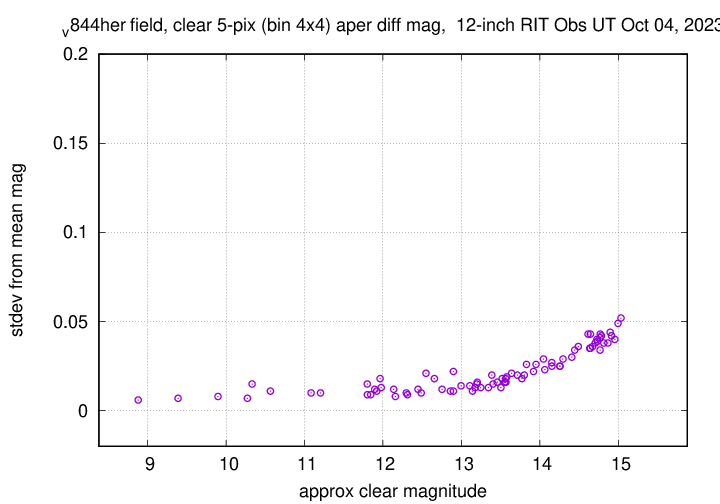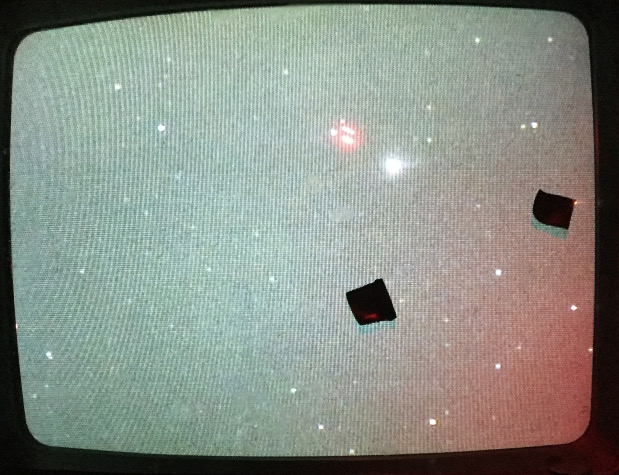
On the night of Oct 03/04, 2023, under good conditions, I acquired several different datasets:
For various reasons, the results of V844 Her aren't very interesting, but the experience was valuable.
As described by AAVSO Alert Notice 834, the cataclysmic variable star V844 Her was found to be in outburst on UT Oct 1. I joined many observers in trying to measure its behavior during the brief period when it is bright.
These observations involved:
Notes from the night:
The position of the variable star is
RA = 16:25:01.7 Dec = +39:09:26.3
At quiesence, it has magnitude V = 18-ish, but can rise to V = 12 in an outburst.
The picture below, based on images taken this evening, shows the area around V844 Her. The field of view is about 22 arcminutes across.

I've marked the location of several comparison stars.
star AAVSO ID B V ------------------------------------------------------ A 106 11.703 10.611 --------------------------------------------------------------------------
The 14-inch images did have a nice PSF: with a plate scale of approximately 0.640 arcsec/pixel, the FWHM of 2.4 pixels corresponds to 1.5 arcseconds. Very nice!
However, the measurements made through the 14-inch can't be properly cleaned, because I lack darks and flats. I measured the brightness of stars anyway, in the raw images, and applied the usual ensemble photometry. The 10-second unfiltered exposures yielded the following sigma-vs-mag relationship:

A light curve of V844 Her and some comparison stars shows a gradual rise:

When I moved to the 12-inch telescope, I increased the exposure time from 10 seconds to 20 seconds. The sigma-vs-mag graph doesn't rise as quickly -- no surprise with the extra exposure time.

I had to cut the sequence short as the target was setting below 30 degrees. The measurements on the 12-inch show a slight fading.

The overall pattern of a rise, followed by a fade, is exactly what is seen in the AAVSO measurements for this time. Since my values are split up, and my run is short, and at least three other observers cover the same period, I decided not to submit my 12-inch measurements. Sigh.
But it was useful to test the 14-inch again, for the first night in quite some time.
Ross 248 is a relatively faint red star surrounded by many other stars of similar brightness, so it's a good candidate for high-precision parallax measurements.
The object is (currently) near position
RA = 23:41:55.27 Dec = +44:10:06.38 (J2000)
A chart of the field is shown below. The size of the chart is about 41 x 27 arcminutes. The noisy area at right (West) is the shadow of the guider's pickoff mirror.

I've marked the location of several comparison stars.
star UCAC4 B V r ------------------------------------------------------------------------- A UCAC4 671-120730 12.617 10.689 B UCAC4 671-120688 C UCAC4 671-120749 10.987 10.663 P kappa And 4.06 4.14 --------------------------------------------------------------------------
I took a photo of the finder TV's screen when pointing to Ross 248; this could be a useful reference for the future:

In order to get the best results for Ross 248, it is necessary to use only a subset of the stars in the camera's full field of view. For this evening's data, I chose the "intermediate" subset, and restricted matches to those stars within about 11 arcminutes of the target.
Here are the positions I've measured so far. The most recent measurements are at bottom right.

Like Ross 248, GX And is a nearby (binary) star which will be the target of a parallax project in the coming year. One of the two components is bright -- about mag V = 8 -- so one must use short exposures to prevent it from saturating the detector. That may mean that this system isn't as easy to measure as Ross 248 or some others.
On this night, for GX And,
The object is currently close to this position:
RA = 00:18:28.4 Dec = +44:01:31 (J2000)
but it does have a very high proper motion.
A chart of the field is shown below. The size of the chart is about 41 x 27 arcminutes. The noisy area at right (West) is the shadow of the guider's pickoff mirror.

The two components of the GX And binary sit inside the box. I've marked the location of several comparison stars as well.
star UCAC4 B V r ----------------------------------------------------------- A 671-001473 9.939 9.790 B 670-001639 9.413 8.472 C 671-001509 12.712 11.421 11.001 -----------------------------------------------------------
I took a photo of the finder TV's screen when pointing to GX And; this could be a useful reference for the future:

Using the same techniques as described for earlier nights, I matched detected stellar positions to the Gaia DR2 catalog, using all the stars in the "intermed" reference set.
The target is moving to the upper-right with time, and clearly shows the back-and-forth motion due to parallax.
